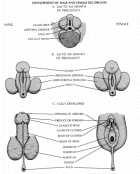|
Sex - Basic Aspects of Human Sexuality
|
|
Development of primary sexual characteristics
|
|

Click on picture.
|
The physical difference between the sexes is not as great as it may appear at first glance. Even the female and male sex organs are structurally very similar. Indeed, in the first weeks of their development they are practically indistinguishable. It is only their subsequent growth before birth and later during puberty which makes them complementary to each other for the purpose of procreation. However, even then once can still find corresponding, i.e. "homologous" structures that originated in the same cell mass.
|
|
Girls
Before birth
Both sexes start from a common base
Female and male embryos remain undifferentiated during the first weeks of their lives. They already have a head and limb buds which begin to grow into arms and legs. They also have a ridge of tissue destined to grow into sex organs. However, all one can see at this point is a hump (suggestive of the male) and a groove (suggestive of the female).
Typical female development
In the female embryo the hump grows into the clitoris, and the groove remains open. It gradually forms the inner lips and the anterior part of the vagina. Two patches of skin on either side develop into the outer lips. Another cell mass develops into ovaries. At birth, the internal and external sex organs are clearly defined as female.
During puberty
The female sex organs reach their full size and function only during puberty, usually between the ages of 11-13. Indications of sexual maturity in this sense are the growth of pubic hair and the first menstruation.
Boys:
Before birth
Both sexes start from a common base
Female and male embryos remain undifferentiated during the first weeks of their lives. They already have a head and limb buds which begin to grow into arms and legs. They also have a ridge of tissue destined to grow into sex organs. However, all one can see at this point is a hump (suggestive of the male) and a groove (suggestive of the female).
Typical male development
In the male embryo the hump grows into the penis, and the groove closes. Another cell mass grows into testicles which begin to produce the hormone testosterone. This hormone, in turn, stimulates further growth and differentiation. (Without it, the embryo would “automatically” grow into a female.) Two patches of skin on either side of the hump form the scrotum. Between the seventh and ninth month of pregnancy, the testicels descend into the scrotum. (If they fail to descend, some later correction is required in order to prevent infertility.) At birth, the internal and external sex organs are clearly defined as male.
During puberty
The male sex organs reach their full size and function only during puberty, usually between the ages of 12-17. Indications of sexual maturity in this sense are the growth of pubic hair and the first ejaculation of semen.
|

